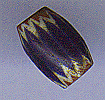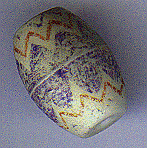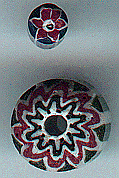|

|
Chevrons received their English names from the chevron pattern seen on the sides of the beads after they have been ground on the ends.
|
|
The earliest chevron imitations were glass but wound, not drawn. Their distribution and lead content led me to believe they are Chinese (Jamey does not concur). A variety has been made over thecenturies.
From Adhyatman and Arifin Beads in Indonesia
|

|
|

|
An imitation with a thin design. I thought this was made by the Prosser technique (forming powdered glass into molds by pressure). Jamey believes it is porcelain and reports hollow examples.
Donor: Robert Liu
|
|
Contemporary American glass beadmakers have tried their hands at chevron making. This one is by Brian Kerkvliet.
Donor: Brian Kerkvliet
|

|
|

|
The American glass chevron pioneer is Art Seymour. This one has no less than eleven layers. He has made them at least up to fifteen layers.
Donor: Art Seymour
|
|
The glass beadmakers of Purdalpur, India have gotten into the act. Their first chevrons (top) were obviously made by the hot-strip mosaic method without molds. They have greatly improved, but are still using the hot-strip method (bottom).
Thanks especially on this one, Jamey.
For more on molded and non-molded chevrons
see here.
|

|





